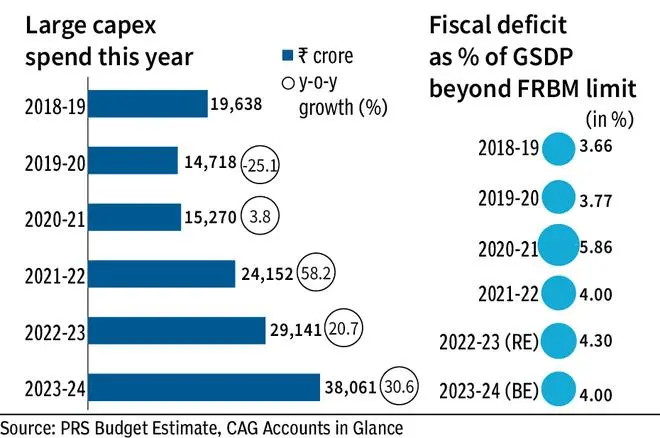Rajasthan Chief Minister Ashok Gehlot has articulated ambitious economic objectives for the State, envisioning a Gross Domestic Product (GDP) of ₹30-lakh crore by 2030. Central to his election campaign is the emphasis on the government’s role in reshaping Rajasthan from a historically underdeveloped State into one of the ‘leading States’ over the past five years. The stark contrast between the ambitious figures and aspirations and the actual economic situation has become a point of contention and debate ahead of the elections.
Undue focus on agriculture
From 2018-19 to 2022-23, Rajasthan’s GSDP has shown a competitive growth rate to all-India’s GDP.
The incumbent government has, however, focused on developing agriculture and allied activities. The contribution of this sector was 28.95 per cent to the State’s total Gross State Value Added (GSVA) in 2022-23; increasing from 25.85 per cent in 2018-19. While the share of industry has also edged up slightly in this period, the share of services has declined to 43.74 per cent in 2022-23 from 47.88 per cent five years ago.
Lack of progress in services is a shortcoming, which impedes faster growth in the State.

Fiscally not prudent
The State has not been able to rein its fiscal deficit, which has expanded due to its large revenue expenditure. Fiscal deficit, as a per cent of GSDP, expanded to 5.86 per cent in FY21, but it is still high at 4 per cent as per the Budget for FY24.
This is despite the State projecting own tax revenue growth of 23 per cent for FY24, led by growth in State GST collections of 36 per cent. These numbers appear overstretched.

Inability to rein the fiscal deficit is leading to expansion in borrowing. Debt and other liabilities of the State were ₹3,11,374 crore (34 per cent of GSDP) in 2018-19 which rose to Rs 4,62,845 (38% of GSDP) in 2021-22. These high borrowings lead to high interest burden with lowers other productive spends.

In 2022, the Reserve Bank of India sounded the alarm, indicating that fiscal conditions among Indian States, including Rajasthan, are displaying concerning signals of increasing strain, particularly evident in the elevated debt burden as measured by the debt-to-GSDP ratio.
Facts and figures
Dr Rajesh Kothari, a Distinguished Professor at IIHMR University, Jaipur, and a former professor at University of Rajasthan, critiques the government’s projections, asserting that they lack depth.
According to Dr Kothari, the economic condition in Rajasthan is fundamentally frail, marked by a surge in the cost of living attributed to unchecked government spending directed towards winning forthcoming State assembly elections by giving freebies. He highlights the burden of government borrowings and the allocation of funds towards popular schemes. Moreover, Kothari points out the absence of sustainable industrial growth, attributing it to a paralysed industrial policy. In his view, the current economic environment in the State is not conducive to achieving projected GDP growth.
“The mounting deficit of the State electricity boards, the upcoming financial burden on the State exchequer because of Old Pension Scheme, derailing infra growth, especially public transport, absence of clear cut policy mechanism for job creation, self-employment, incomplete allocation etc are further dragged on the economic growth of the State,” he said.







Comments
Comments have to be in English, and in full sentences. They cannot be abusive or personal. Please abide by our community guidelines for posting your comments.
We have migrated to a new commenting platform. If you are already a registered user of TheHindu Businessline and logged in, you may continue to engage with our articles. If you do not have an account please register and login to post comments. Users can access their older comments by logging into their accounts on Vuukle.